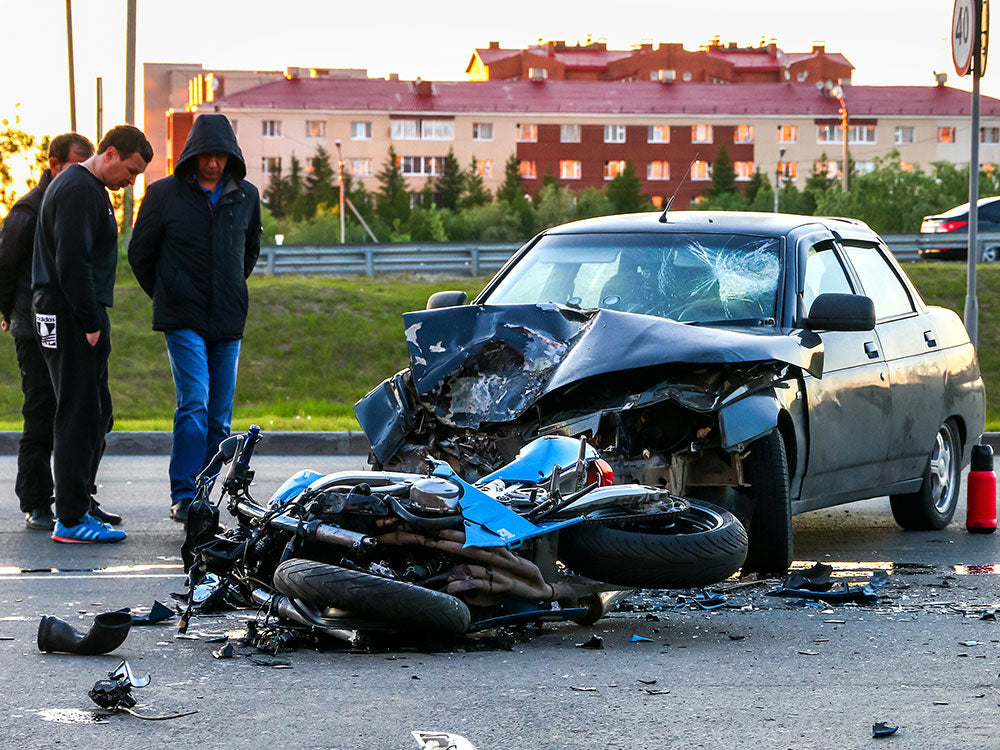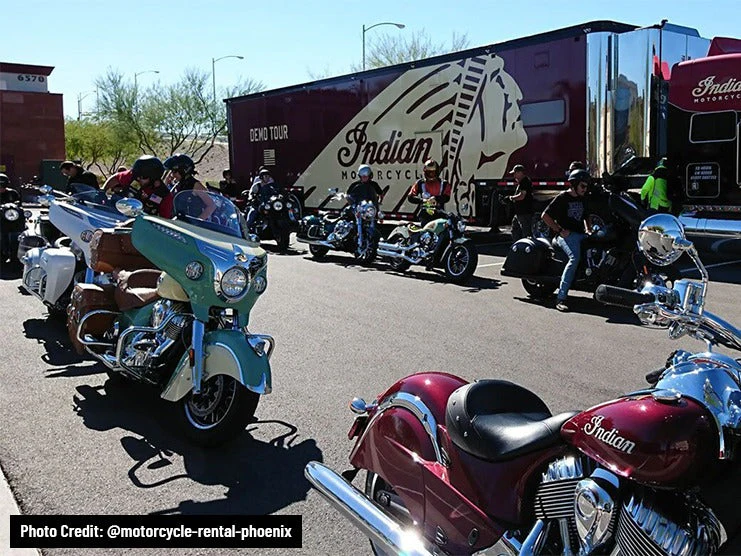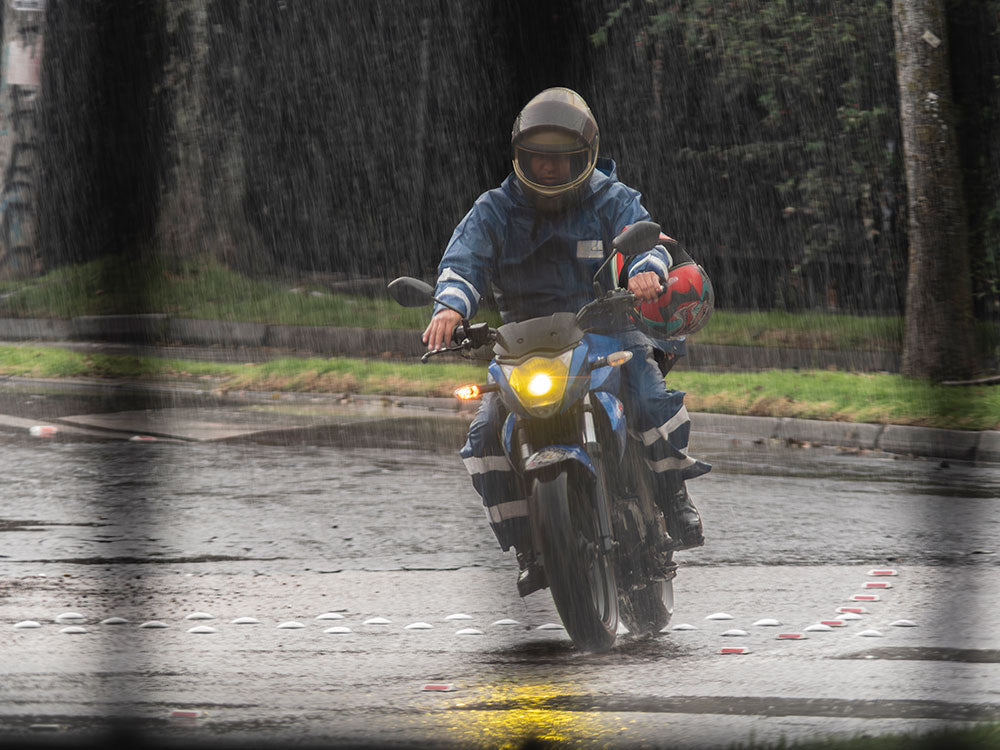Table of Content
1. Speed
Although most riders try to travel at or below the speed limit, motorcyclists frequently ride at excessive speeds when turning, causing them to crash. Due to the minimal protection that motorcycles provide, most crashes often end in a trip to the hospital.
When speed is the primary cause of a motorcycle crash, fatalities and severe injuries are more likely to occur. Younger, less experienced motorcyclists are more likely to be involved in motorcycle crashes due to excessive speed.
Traveling over the speed limit is considered an excessive rate of speed.
For instance, if the speed limit is 50 mph but there is a windstorm, traveling at 50 mph is considered unsafe due to decreased vision during a windstorm. The NHTSA reports that speeding contributed to 32% of motorcycle fatalities in 2017.
No matter how well-lit the roads are or how much control you have over your motorcycle, riding over the speed limit puts you and other drivers at risk.
Sadly, speed contributes to motorcycle crashes for both solo and group rides. One may prevent the risk of a crash by keeping the most experienced rider at the rear and the least experienced rider at the front. Before every trip, go through the safe group riding guidelines. Also, maintain a sensible speed that ensures all riders will be able to keep up.
2. Road Conditions
You likely will come across hazardous road conditions while traveling on your motorcycle. The likelihood that a motorcycle rider may lose control of his/her motorcycle can increase due to poor road conditions or obstacles like potholes, cracked pavement, debris, and a lack of traffic signals and signs.
Road conditions are one of the most common factors in motorcycle accidents, however many motorcyclists frequently ignore this risk.
Motorcycles are more vulnerable to hazardous road conditions than larger vehicles since they are so much smaller and less stable.
The following road conditions might cause a motorcycle crash:
- Badly lit intersections and highways
- Improperly defined curves or merging zones
- Faulty pavement
- Unmarked lane changes
- Hidden driveways
- Risky bridge joints
- Dangerous railroad tracks
- Sand, gravel, or rubble
- Grass or leafy debris
- Flowing or standing water
Another potential road hazard that motorcyclists may not see as a danger is the condition of a corner. There are some corners with decreased radius and off-camber turns that make it difficult for riders to clear corners safely.
3. Inexperience
Novice riders might not be properly prepared for the risks they will face on the open road if they have only ever practiced in a parking lot. Unfortunately, many riders get on their motorcycles with little to no knowledge of road hazards.
Too many motorcyclists, sadly, do not even have valid motorcycle licenses. For motorcyclists who ride without a license, lack of experience and proper instruction can have devastating effects. In 2012, nearly one-fourth of all fatally injured motorcycle riders lacked a valid license and adequate riding experience.
All motorcyclists should spend a lot of time practicing before hitting the road.
All novice riders would benefit from honing their riding skills by practicing on less difficult roads. The majority of motorcycle schools and organizations also provide ongoing education programs and even one-on-one coaching. Everything from fundamental motorcycle operations to life-saving riding drills is covered in motorcycle riding lessons.
4. Weather Conditions
Uncontrollable elements like bad weather might also result in an unsafe riding environment. Motorcycles are more at risk than other vehicles to bad weather. Travel with extreme caution when riding your motorcycle when it is raining due to low visibility and slick surfaces, or when coming across obstacles on the roadway.
Motorcyclists should monitor the weather forecast and conditions before going for a ride. Serious accidents can happen when other drivers are unable to notice motorcycles due to bad weather like rain, snow, or ice.
Motorcycle riders should also expect their tires to have less grip on areas with paint or tar during warmer months. Falling leaves and plant debris can seriously reduce traction. The first few rains are especially important for washing away the gravel, oil, salt, and debris that accumulate during spring. Rainstorms can be dangerous for motorcyclists because they reduce traction, impair visibility, and frequently cause noticeable drops in temperature.
On roads, dangerous road conditions can be caused by the surface being covered in snow, sleet, ice, or rain. All riders should use caution when driving in inclement weather. When a motorcyclist behaves recklessly or negligently while riding in a storm or blizzard to avoid a collision that could result in severe injuries.
5. Alcohol & Drugs
Driving while under the influence, whether due to alcohol or drugs can cause you to make careless decisions.
Alcohol can affect a rider's ability to maintain balance, maintain control of his/her motorcycles, gauge distance and slow down, and hinders reaction time.
According to the NHSTA, nearly 30% of motorcycle riders involved in fatal collisions had blood-alcohol concentrations over the legal limit, and nearly 45% of motorcycle riders involved in fatal collisions had some alcohol in their systems.
Motorcycling under the influence can suffer from the following problems:
- Poor Judgment
- Inclination for Hazardous Behaviour
- Delayed Reaction Time
- Lowered Inhibitors
6. Lane Splitting
Lane splitting is a way for motorcyclists to bypass heavy traffic, but it is extremely risky to do so since you are squished between larger vehicles and they may not see you coming. Many drivers in cars or trucks fail to fully scan their surroundings and do not see motorcycles splitting lanes coming from behind. Lane splitting is considered illegal in numerous states for this precise reason.
Even in a car or truck, it may be rather alarming when a vehicle in the other lane suddenly swerves into the area you're using. But for motorcyclists and blind areas, the result is horribly catastrophic.
Because of how close a motorbike is to other vehicles when on lane splitting how little space is left to maneuver around the automobiles, and how unexpected it is for a motorcycle to overtake a car in a traffic jam, lane splitting can easily result in an accident.
When accidents occur due to lane splitting, motorcyclists are often considered at fault for these collisions, but it usually depends on the state’s motorcycle laws supporting or opposing lane splitting, the input of police officers and judges, and the circumstances surrounding the collision.
According to O.C.G.A., motorcyclists must follow these rules:
- A motorcyclist can’t overtake or travel into a lane occupied by other vehicles.
- A motorcyclist can’t operate between traffic lanes.
7. Distractions
Like all drivers, motorcycle riders may become easily distracted. Keep both hands on the handlebars and your eyes on the road at all times.
Many drivers who share the road with motorcyclists are multitasking, resulting in many of them failing to see an approaching motorcycle.
Distracted driving is currently the root cause of at least 10% of all fatal traffic accidents in the U.S. alone. Since 2003, driver mobile phone use has increased by almost 1,500%.
Motorcycle awareness programs are being held all over the world in an effort to retrain drivers to look out for motorcyclists, but bikers must remain alert at all times for distracted drivers.
Maintaining an appropriate following distance, investing in collision avoidance technology, and wearing highly visible clothing are several precautionary steps that motorcyclists can take.
8. Left-Hand Turns
Making a left turn while riding a motorcycle has sometimes led to crashes with oncoming traffic. Sadly, left-turn accidents are the most common type of motorcycle collision globally.
Motorcyclists frequently suffer injuries and fatalities as a result of misunderstandings regarding the right of way or poor distance calculations when making a left turn.
36% of fatal motorcycle accidents involve left turns, according to the National Highway Traffic Safety Association. This is the most frequent motorcycle accident, which occurs when a vehicle comes in front of a rider while not seeing them or judging their speed inaccurately.
These crashes may occur when:
- A driver turning left strikes a motorcycle that is traveling straight through an intersection.
- When turning left or through the junction, a motorcycle rider gets struck by a driver who is passing another car.
9. Collisions
When motorcycles collide with other vehicles and stationary objects, the riders are at greater risk than drivers in cars, vans, or trucks. Unlike four-wheelers, motorcycles do not have a metal cage to offer protection or airbags to cushion the rider.
Here are the most common types of motorcycle collisions:
9.1 Head-On Collisions
According to the NHTSA, nearly 5,114 fatal motorcycle incidents in 2019 involved another moving vehicle. About 75% of these collisions involved the motorcycle being struck in the front by the other vehicle. Meanwhile, on average, 7% of motorcycles were rear-ended.
Due to four-wheelers weighing more than two-wheelers and the lack of safety equipment on motorcycles, head-on collisions are among the deadliest motorcycle accidents.
9.2 Collisions With Fixed Objects
Motorcycle riders were more likely to die due to crashes with fixed objects than with other vehicles in 2019. For instance, when a motorcyclist veers off a rain-slicked road and collides with a tree or a fence, they may suffer serious injuries or perhaps pass away. Fixed object collisions accounted for 23% of the 5,114 fatal motorcycle accidents in 2019 as opposed to 16% for passenger vehicles, 13% for light trucks, and 4% for heavy trucks.
10. Failure to Notice the Motorcycle
Other vehicles failing to see other motorcycles is the leading cause of motorcycle crashes. Almost half of all motorcycle accidents are due to a lack of visibility. A motorcyclist can increase visibility by doing the following:
- Use a headlight, tail light, and turn signals
- Never drive in a car’s blind spot
- Wear colorful clothes
Approximately 70% of motorcycle crashes occur at intersections because drivers fail to see motorcycles. As motorcycles are smaller in size, other vehicle drivers fail to gauge how fast a motorcycle can turn into its path.
11. How Harmful Can a Motorcycle Crash Be?
Motorcycle crashes are extremely dangerous and even fatal sometimes. The chances of death in motorcycle crashes are much higher than in any other vehicle because of the lack of safety features. Riders can suffer severe injuries in a motorcycle crash, including
- Broken Bones and Burns
- Facial Fractures
- Spinal Cord Injuries
- Head and Brain Injuries
- Neck Injuries
- Lacerations
12. Last Words
Many people enjoy riding motorcycles, but doing so can be dangerous. Motorcycle fatalities are common because motorcycles offer less protection than other vehicles. According to the National Highway Traffic Safety Administration (NHTSA), almost 80% of motorcycle crashes result in serious injury or death in 2018. You can keep yourself safe during a motorcycle ride by being mindful of the main causes of crashes and knowing how to avoid them. You should carry protective gear in your motorcycle luggage. You can increase motorcycle storage capacity by getting leather, hard, or universal saddlebags. You can save some money by getting aftermarket parts, including sissy bars, crash bars, or fairings.













Leave a comment
All comments are moderated before being published.
This site is protected by hCaptcha and the hCaptcha Privacy Policy and Terms of Service apply.